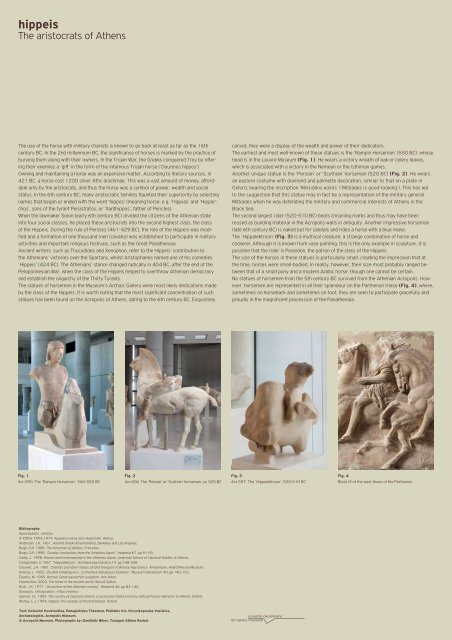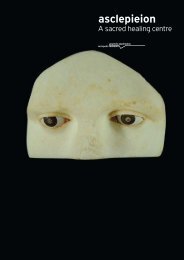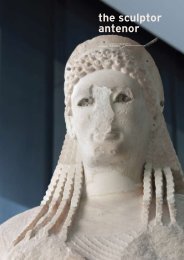The aristocrats of Athens
The aristocrats of Athens
The aristocrats of Athens
Create successful ePaper yourself
Turn your PDF publications into a flip-book with our unique Google optimized e-Paper software.
hippeis<strong>The</strong> <strong>aristocrats</strong> <strong>of</strong> <strong>Athens</strong><strong>The</strong> use <strong>of</strong> the horse with military chariots is known to go back at least as far as the 16thcentury BC. In the 2nd millennium BC, the significance <strong>of</strong> horses is marked by the practice <strong>of</strong>burying them along with their owners. In the Trojan War, the Greeks conquered Troy by <strong>of</strong>feringtheir enemies a ‘gift’ in the form <strong>of</strong> the infamous Trojan horse (‘Doureios hippos’).Owning and maintaining a horse was an expensive matter. According to literary sources, in421 BC, a horse cost 1200 silver Attic drachmae. This was a vast amount <strong>of</strong> money, affordableonly by the <strong>aristocrats</strong>, and thus the horse was a symbol <strong>of</strong> power, wealth and socialstatus. In the 6th century BC, many aristocratic families flaunted their superiority by selectingnames that began or ended with the word ‘hippos’ (meaning horse; e.g. ‘Hippias’ and ‘Hipparchos’,sons <strong>of</strong> the tyrant Peisistratos, or ‘Xanthippos’, father <strong>of</strong> Pericles).When the lawmaker Solon (early 6th century BC) divided the citizens <strong>of</strong> the Athenian stateinto four social classes, he placed these <strong>aristocrats</strong> into the second highest class, the class<strong>of</strong> the Hippeis. During the rule <strong>of</strong> Pericles (461-429 BC), the role <strong>of</strong> the Hippeis was modifiedand a formation <strong>of</strong> one thousand men (cavalry) was established to participate in militaryactivities and important religious festivals, such as the Great Panathenaia.Ancient writers, such as Thucydides and Xenophon, refer to the Hippeis’ contribution tothe Athenians’ victories over the Spartans, whilst Aristophanes named one <strong>of</strong> his comedies‘Hippeis’ (424 BC). <strong>The</strong> Athenians’ stance changed radically in 404 BC, after the end <strong>of</strong> thePeloponnesian War, when the class <strong>of</strong> the Hippeis helped to overthrow Athenian democracyand establish the oligarchy <strong>of</strong> the Thirty Tyrants.<strong>The</strong> statues <strong>of</strong> horsemen in the Museum’s Archaic Gallery were most likely dedications madeby the class <strong>of</strong> the Hippeis. It is worth noting that the most significant concentration <strong>of</strong> suchstatues has been found on the Acropolis <strong>of</strong> <strong>Athens</strong>, dating to the 6th century BC. Exquisitelycarved, they were a display <strong>of</strong> the wealth and power <strong>of</strong> their dedicators.<strong>The</strong> earliest and most well-known <strong>of</strong> these statues is the ‘Rampin Horseman’ (550 BC), whosehead is in the Louvre Museum (Fig. 1). He wears a victory wreath <strong>of</strong> oak or celery leaves,which is associated with a victory in the Nemean or the Isthmian games.Another unique statue is the ‘Persian’ or ‘Scythian’ horseman (520 BC) (Fig. 2). He wearsan eastern costume with diamond and palmette decoration, similar to that on a plate inOxford, bearing the inscription ‘Μιλτιάδης καλός’ (‘Miltiades is good-looking’). This has ledto the suggestion that this statue may in fact be a representation <strong>of</strong> the military generalMiltiades when he was defending the military and commercial interests <strong>of</strong> <strong>Athens</strong> in theBlack Sea.<strong>The</strong> second largest rider (520-510 BC) bears chiselling marks and thus may have beenreused as building material in the Acropolis walls in antiquity. Another impressive horseman(late 6th century BC) is naked but for sandals and rides a horse with a blue mane.<strong>The</strong> ‘Hippalektryon’ (Fig. 3) is a mythical creature, a strange combination <strong>of</strong> horse andcockerel. Although it is known from vase painting, this is the only example in sculpture. It ispossible that the rider is Poseidon, the patron <strong>of</strong> the class <strong>of</strong> the Hippeis.<strong>The</strong> size <strong>of</strong> the horses in these statues is particularly small, creating the impression that atthe time, horses were small-bodied. In reality, however, their size most probably ranged betweenthat <strong>of</strong> a small pony and a modern Arabic horse, though one cannot be certain.No statues <strong>of</strong> horsemen from the 5th century BC survived from the Athenian Acropolis. However,horsemen are represented in all their splendour on the Parthenon frieze (Fig. 4), where,sometimes on horseback and sometimes on foot, they are seen to participate gracefully andproudly in the magnificent procession <strong>of</strong> the Panathenaia.Fig. 1Acr.590, <strong>The</strong> ‘Rampin Horseman’. 560-550 BCFig. 2Acr.606, <strong>The</strong> ‘Persian’ or ‘Scythian’ horseman. ca. 520 BCFig. 3Acr.597, <strong>The</strong> ‘Hippalektryon’. 520-510 BCFig. 4Block ΙΧ <strong>of</strong> the west frieze <strong>of</strong> the Parthenon.BibliographyΑριστοφάνης. «Ιππείς».Α’ ΕΠΚΑ, ΤΑΠΑ.1979. Αρχαϊκοί ιππείς στην Ακρόπολη. Αθήνα.Anderson, J.K. 1961. Ancient Greek Horsemanship. Berkeley and Los Angeles.Bugh, G.R. 1988. <strong>The</strong> horsemen <strong>of</strong> <strong>Athens</strong>. Princeton.Bugh, G.R. 1998. “Cavalry inscriptions from the Athenian Agora”. Hesperia 67. pp 81-90.Camp, J. 1998. Horses and horsemanship in the Athenian Agora. American School <strong>of</strong> Classical Studies at <strong>Athens</strong>.Camporeale, G.1967. “Hippalektryon”. Archaeologia Classica 19. pp 248-268.Crouwel, J.H. 1981. Chariots and other means <strong>of</strong> land transport in Bronze Age Greece. Amsterdam, Allard Pierson Museum.Doenig, J. 1983. “Ξουθός Ιππαλεκρύων. La monture fabuleuse l’Ouranos”. Museum Helveticum 40. pp 140-153.Eaverly, M. 1995. Archaic Greek equestrian sculpture. Ann Arbor.Hyland Ann, 2003. <strong>The</strong> horse in the ancient world. Stroud Sutton.Kroll, J.K. 1977. “An archive <strong>of</strong> the Athenian cavalry”. Hesperia 46. pp 83-140.Ξενοφών. «Ιππαρχικός», «Περί ιππικής».Spence, I.G. 1993. <strong>The</strong> cavalry <strong>of</strong> Classical Greece: a social and military history with particular reference to <strong>Athens</strong>. Oxford.Worley, L.J. 1994. Hippeis: the cavalry <strong>of</strong> Ancient Greece. Oxford.Text: Kotsarini Konstantina, Panagiotidou <strong>The</strong>odora, Plaitakis Iris, Chrysikopoulos Vasileios.Archaeologists, Acropolis Museum.© Acropolis Museum. Photographs by: Daniilidis Nikos, Tsangari Athina Rachel.






